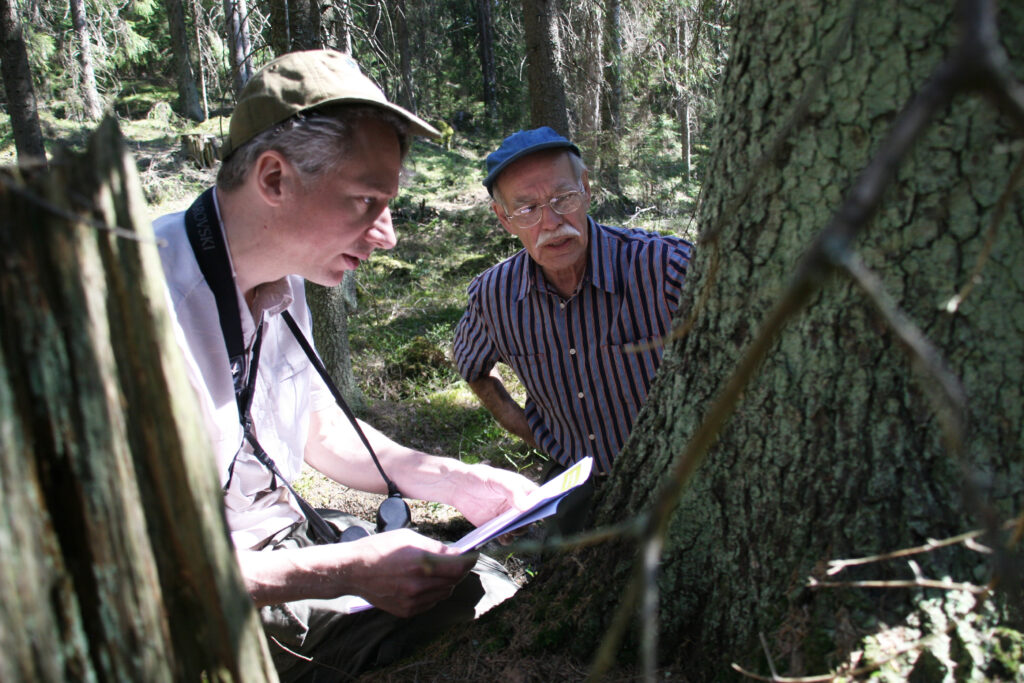Forest sector is developing tools for nature management – Protection of endangered species as model in Multi-Forest project

Nature management is part of everyday forestry work. Now, the Multi-Forest project aims at consolidating the use of tried and tested means of increasing biodiversity throughout Finland.
Forest owner Lauri Syrjänen peers at the stem of a sturdy spruce. The spruce and its neighbours sport red ribbons because an endangered lichen, Arthonia leucopellaea, grows on them.
Syrjänen was informed of the rare lichen when he wanted to thin his forest in Vihti in Southern Finland and made the compulsory notification of forest use to the authorities. A biologist had noticed the lichen and registered it in the information system of the Finnish Environment Institute, and the official processing Syrjänen’s notification of forest use noted this and passed the information to him.
Syrjänen omitted to fell the spruces covered by yellowy-white vegetation, even though no legislation or certification criterion obliges him to do so. “I’m happy to be involved in nature conservation whenever there’s a chance. It is only smart to pass information directly from experts to the forest owners,” he says.
Multi-Forest project aims at changing practices
For a few years, the voluntary protection of endangered species has been improved using simple and cost-effective means. Data gathered by the environmental administration is now transmitted to the forest sector and forest owners. In the best case, this approach to the protection of threatened forest species is taken into account at the stage when forestry actions are planned.
The Ministry of Agriculture and Forestry now wants to enhance nature management together with the forest sector. The ministry has launched the Multi-Forest project, which examines nature management methods already in use but not widely established. The aim is to disseminate cost-effective practices suitable for day-to-day forest management throughout the country.
“Because of the increasing demand for wood, it becomes increasingly important to pay attention to biodiversity,” says Ms. Katja Matveinen, specialist at the Ministry of Agriculture and Forestry. She points out that nature management as part of normal forest management is recognized in the national forest strategy, and voluntary measures to ensure diversity are also mentioned in the programme of the current government.
According to Matveinen, endangered species are particularly important in that they reveal how Finnish forest management can also improve biodiversity. The Red List Index shows that Finnish forest species are clearly among the most vital and the Red List of threatened species of 2010 states that the rate at which species are becoming endangered has slowed down in forests.
“We have developed methods, such as leaving retention trees, which have improved the situation of many endangered species. Making successful measures a part of established practice is the basic idea of the Multi-Forest project, too,” says Matveinen.
Finland’s endangered species live in commercial forests
To ensure that the ideas from the three-year Multi-Forest project will take root inpractice, the project involves a wide range of forest actors: the Ministry of Agriculture and Forestry, the Central Union of Agricultural Producers and Forest Owners MTK, the Finnish Forest Industries Federation, the Finnish Forest Centre, Tapio consulting services, the Finnish Wildlife Agency, the Finnish Environment Institute SYKE, the Natural Resources Institute LUKE and WWF.
“Nature management already works in practice, but there is room for improvement in guidelines, communication and education,” says Ms. Lea Jylhä, specialist at MTK, the Central Union of Agricultural Producers and Forest Owners. “The vast majority of Finnish forests are in commercial use. Therefore, the management of commercial forests is of paramount importance for forest biodiversity in Finland. ”
The Finnish Forest Industries Federation brings forestry companies into the project – as forest owners and actors in forest management. According to Inka Musta, Forestry Specialist at the Federation, practical guidelines for nature management are welcome. She points out that nature management in commercial forests has only been discussed during the past twenty years. “An essential part of the project is providing advice and information about the importance of nature management.”
According to Mr. Matti Seppälä, Leading Expert at the Finnish Forestry Centre, the Multi-Forest project aims to review all methods mentioned in the official guidelines for forestry activities. “In particular, I could highlight the systematic preservation of decayed wood, the use of information related to particular species and locations when planning actions, and the targeted enhancement of water protection, such as drainage in connection with forest regeneration,” says Seppälä.
According to forest owner Lauri Syrjänen, patience is the most essential thing in forest and nature management. “Nature’s ability to renew itself is often overlooked because it takes time. My forest here is known to have been clear-cut in the 1910s, but after a hundred years, even a rare lichen grows here.”
The article is also based on an interview with Mr. Lauri Saaristo, Project Manager at Tapio consulting services, in charge of parts of the Multi-Forest project.
Ministry of Agriculture and Forestry
Forest species less endangered than before (forest.fi 22.01.2016)
Kirjoita kommentti